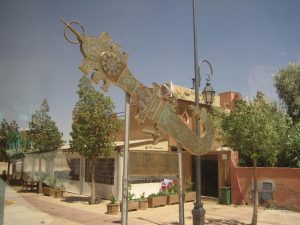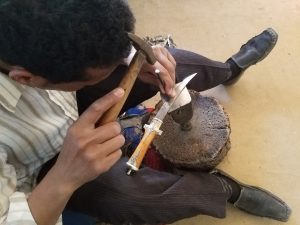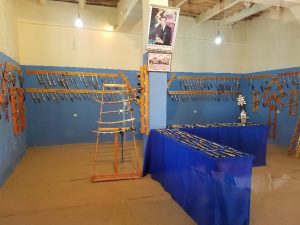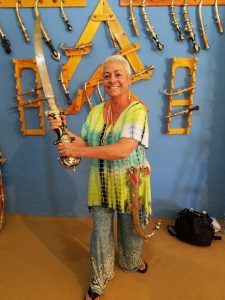
AZLAG Dagger Cooperative Now Trains Girls in Centuries Old Local Craft
By Cheri Varnadoe
As part of our exposure to the many faces of sustainability, the ASU Sustainability Across Morocco Study Abroad group visited the AZLAG Dagger Cooperative in the village of Kelaat M´Gouna, Morocco. Our professor learned of this cooperative through an ASU Global Technology & Development alumnus who had worked with the dagger cooperative during his time in the Peace Corp in Morocco. The alumnus did a project on how social media could help the cooperative increase their business. At his suggestion, the president of the cooperative traveled to Arizona for the Tucson Minerals and Gem Show. Our professor, who had met the coop’s director when she took the 2013 Morocco Study Abroad group to visit the cooperative, was now able to return the favor by translating for him at the Gem Show. This was just one of many examples of the global interconnectedness of the ASU network, which enabled our group to have such an immersive experience.

For more than seven centuries, the men in this village have been hand crafting high quality, intricately engraved daggers. They are known for making the best daggers in the country. As evidence, the town square proudly displays an AZLAG Dagger Cooperative piece that took first place in a national government sponsored competition. This dagger is six meters high and weighs 500 kilos. It took eight men 25 days to make it. It is valued at 80,000 dirhams, approximately $8,000 US. The local government purchased it from the cooperative to display in the center of town. The AZLAG Dagger Cooperative has won the national competition 4 years in a row.
According to our host, a man in his village used to feel “undressed without a dagger”. With modern times, that custom has dwindled and now they only carry a dagger on special occasions. This, of course, has reduced the demand for these daggers, putting the village’s livelihood and this revered craftsmanship at risk. There is an old wedding tradition in Kelaat M´Gouna where the bride is given milk and honey as a wedding gift. She, in turn, gifts her groom with a dagger. Once they are married, the bride dips the dagger into the honey and uses it to mark the door of their new home, signifying a long and fruitful marriage.
With young people waiting longer to marry and leaving their villages for greater opportunities in the cities, one can imagine a continued decline in the demand for AZLAG’s daggers. Movement out of the village has also diminished the number of young men interested in continuing the dagger making tradition.

Against this background, a group of dagger makers in Kelaat M´Gouna founded the AZLAG Dagger Cooperative in 1983, with the goal of providing income to these craftsmen and a way for them to continue this rich tradition in their community. There are approximately 60 members of the cooperative, who have shops at the cooperative’s center on the main road in Kelaat M´Gouna.

The center has a showroom and conference room (or tea salon as it was used during our visit) at the main entrance. This opens on to a courtyard, which is surrounded by small workshops at the sides and back. This is where the craftsmen make their one-of-a-kind daggers, which are then tagged and sold in the main showroom in order to give everyone’s merchandise equal opportunity.
The quantity and variety of daggers displayed in the main showroom is impressive. There are all sizes, from less than one foot long to almost 5 feet long. Their blades are made of stainless steel and can be straight or curved, with curved being the most traditional style. You will find both Touareg (Nomad) and Berber styles. They have handles made of bone, carved wood, engraved copper or steel and all have intricately designed metal sheaths. AZLAG’s designs are unique and known for their detail. The design will always include the Hand of Fatima, a symbol meant to ward off the ‘Evil Eye’ (envy). It takes one man two full days to make a medium sized dagger. Some artisans are known for certain designs, while others create a new design with each dagger.
Boys in the village begin learning how to make daggers around age 13. One of the goals of the coop is to continue this tradition in order to carry on their dagger legacy. So they provide training for the community’s youth and mentor the younger generations of dagger makers. A novice receives two to four weeks of training, then has the opportunity to apprentice. According to the director of the cooperative, it is becoming harder and harder to interest the young men in this tradition. Several factors come in to play such as the aforementioned migration to the cities for economic opportunities. Another is education. Most villages this size only offer school through the sixth grade. In order to pursue one’s education, children must leave their villages and go to live in nearby towns, usually in NGO run boarding houses. Due to cultural and economic considerations, boys are more likely to leave than girls are. In an attempt to address this, the AZLAG Dagger Cooperative will begin teaching their craft to young girls. It will be interesting to see how this somewhat forced gender equality will affect the dagger tradition as well as the future economic situation of the village’s women.

You can learn more about the cooperative and individual dagger artisans, and see and/or purchase their beautiful daggers at http://www.theanou.com/store/39-azlag-dagger-cooperative-kalaat-mgouna-morocco.

